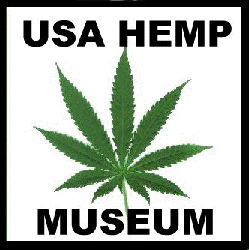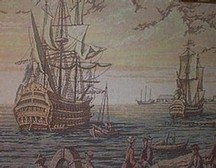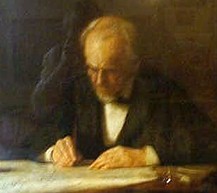|
|
HEMP HISTORY ROOM
USA Hemp Museum
Store |
|
Detail of a Hemp Museum tapestry. ROOM GUIDE |
|
||||||||||||||||
|
Hemp - The Environmentally Sustainable Alternative (Part 1)
1. WELCOME TO THE HEMP HISTORY ROOM.
This room is one of the most exciting in the museum because it shows history from a completely different viewpoint, that of an association between people and a plant. At some of the most important junctures of human civilization, in agriculture, transportation, exploration, communication, war, industry, invention, medicine, and art, hemp was there playing an important role as a basic resource. For some of the history we will take you to different rooms of the Hemp Museum, but first a short overview of history with humans and hemp. Let us begin way back in history.
2. AN OVERVIEW OF HEMP'S HISTORY WITH HUMANS.
 |
Most scientists today consider Africa to be humanity's ancestral birthplace. Other lines of hominid beings, not our direct ancestors, probably died out without leaving Africa. Others over millions of years, spread out of Africa to other parts of the Asian-European continent. One line of hominid dates back 3.3 million years, from an arm and a skull. |
 |
The article on the left from the Los Angeles Times, May 12, 2000, cited two fossil skulls as the earliest evidence that human ancestors migrated out of Africa to the middle east. The skulls were dated to 1.7 million years ago. It may have been on these earliest migrations out of Africa, when ancestral hominids encountered the hemp plant, thought to be native to the middle east or central Asia. |
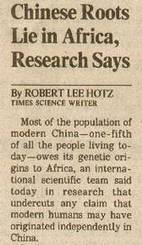 |
Chinese roots lie in Africa says genetic research. This of course lends credence to the above theory that migrations out of Africa spread our Hominid relatives to the rest of the world and that Africa was the cradle of humanity. The time for this spread and differentiation of races is measured in eons. And we can theorize that hemp-hominid encounters, especially for food could have occurred during these first migrations, more than a million and a half years ago. One of the lines of hominid was Homo erectus, who was shown below to have been out of Africa almost a million years ago. |
 |
How early did our ancestors make ropes? The discovery of wood working tools on the island of Flores in Indonesia shows that early man made rafts of bamboo lashed together probably with vines or leather ropes. Could hemp ropes and twine have been far behind? Or was it left to larger brained Homo sapiens to develop hemp rope. |
 |
New DNA research is giving a new picture of the emergence of Homo sapiens out of Africa. By looking at DNA from all around the world, by comparing this data to DNA from Homo erectus, it is postulated that Homo sapiens arose in Africa only 100,000 years ago. I'm guessing that the big brain must have made a world of difference, between Homo sapiens and other hominid groups, because as reported in the L.A. Times, all other hominid groups are extinct, even in Africa. The DNA evidence suggests no cross breeding between species took place. |
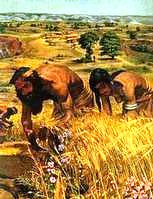 |
Hemp history dates back to the New
Stone Age, 6,000 - 15,000 B.C., in the Middle East, and was one
of the first crops cultivated by people. Reportedly hemp
was the first crop for textile fiber. Agriculture, in
ultimate consequences was a triumph more crucial than any human
achievement before or since. People abandoned the hunter's
economy for the village and farm. The picture on the left is from LIFE MAGAZINE, April 16, 1956, from an article the EPIC OF MAN: The Discovery of Agriculture. |
Hemp rope, twine and fishnets probably predate the weaving of fabric. Hemp rope and saddles set up a human to horse relationship that exists to the present. The oldest saddle ever found was made of hemp by the Scythians of the Siberian steppes.
From the BOOK OF LINEN: "The first use of hemp probably dates all the way back to the third millennium B.C., somewhere in central Asia. Despite its notorious reputation for coarseness, Herodotus noted that skillful Scythians and Thracians in the fifth century B.C. were able to weave fine cloth from hemp: 'Someone without great experience would not recognize whether they were of hemp or linen, and whoever has not yet seen hemp cloth would think the garments were of linen.'" Homespun hemp clothed people for 10,000 years and continues to do so in parts of the world.
The book THE CULTIVATION OF HEMP, also describes hemp's origin: "Hemp's native habitat is Central Asia, where to this day it still grows wild in Iran, Afghanistan, the southern part of Kazakhstan, and some parts of southern Siberia. From these areas, it has spread to the East as well as to the West."
Richard M. Davis speaks on The History Channel program Secrets of the Founding Fathers discussing which US Presidents grew hemp.
Hemp rope and sails carried the commerce and warships of the world for 6,000 years, and allowed the exploration and mapping of the planet by sea. Hemp sailcloth or canvas caught the wind and powered the sailing ship while hemp ropes held up the mighty masts that sometimes towered 16 stories high.
"Long ago when these ancient Grecian temples were new, hemp was already old in the service of mankind. For thousands of years, even then, this plant had been grown for cordage and cloth in China and elsewhere in the Far East." From HEMP FOR VICTORY, a U.S. Department of Agriculture film directed at farmers during World War II, 1942.
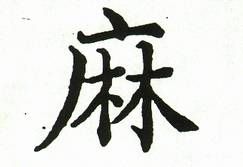 |
B.C. 2700. Chinese characters conceived; Ts'ang
Chieh credited with the invention.
[The ancient Chinese symbol for hemp (left) is 4,700 years old, and shows the male and female forms in a drying shed for fiber use. (Conrad, ibid.).] |
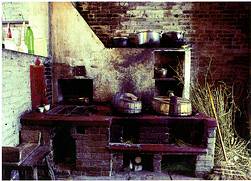 |
Hemp stalks continue to fuel the wok cooking of much of China (A bundle of hemp leans against this Chinese Stove - Hom, Ken., A TASTE OF CHINA). Hemp seed was eaten by humans before recorded time, and hemp seed oil was used as lamp oil throughout history. Hemp or Cannabis medicines have a 5,000 year history of safe use, with not a single death recorded. |
The history of true paper (made from pulped material) and hemp are intimately tied. Paper as the medium of recorded history, ideas, books, and invention moved civilization along at a rate that never could have been achieved without it. The first pulp paper, from 105 A.D., in China, was made of hemp and bark, the first printing was on hemp paper, the first book of hemp paper. For almost two thousand years, rag paper was the standard and hemp was a mainstay of the industry. [See CHRONOLOGY OF PAPER] . Windmills of the Dutch papermakers powered their craft, and hemp was one of the raw materials for their paper.
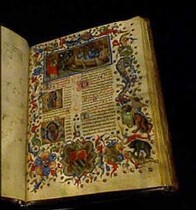 |
Early book showing hand writing and
painting. The book may be of rag paper or vellum, a fine
parchment make of animal skin.
Hemp Museum photo of the Getty Museum book. |
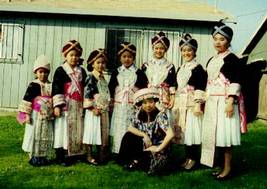 |
Hmong traditional wedding dresses
are made of hemp. (Southeast Asia).
Picture was a gift to the Hemp Museum. |
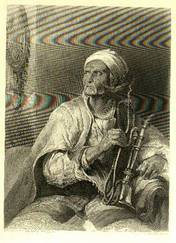 |
Hooka Badar.
Hemp Museum print. |
 |
Bacchante with an Ape. 1627. Hendrick Ter Brugghen Dutch (1588- 1629) Oil on Canvas (Canvas was/is correctly hemp.) Hemp Museum photo of a painting of the Getty Museum, Los Angeles, California. |
Under construction, but visit.
Hemp was the second most important crop in Early America. Guess which crop was the most important?
5.
HEMP IN THE OLD WEST of the U.S.
"The Conestoga wagons and prairie schooners of pioneer days were covered with hemp canvas. Indeed the very word canvas comes from the Arabic word for hemp." (from U.S.D.A. Film, HEMP FOR VICTORY). True canvas is hemp canvas, and in the old West of the United States, tents, wagon covers, ropes, packs, sacks, and some clothes were made of hemp fiber, hemp cloth and hemp canvas. And all were recycled and pulped into paper, so that few examples now exist. Visit the "old West" with hemp.
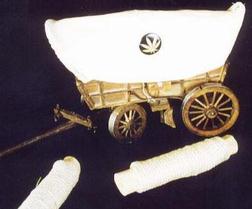 |
The original Hemp Museum model of a
hemp-covered wagon, seen here with hemp stalks wrapped
with hemp rope from Denmark.
Photo: Bill Bridges. |
6. HEMP AND CANNABIS HISTORICAL DEFINITIONS.
HEMP: From LUTHER BURBANK: HIS METHODS AND DISCOVERIES AND THEIR PRACTICAL APPLICATIONS. Volume VIII. 1914. Luther Burbank Press, NY and London.
Chapter IV: A Rich Field For Work In The Textile Plants. P. 108 [Hemp exerts ]
"Flax in America [2 1/4 million acres], is usually grown for the seed only, as the high cost of labor makes competition with the foreign product difficult.
Contrariwise the hemp plant (Cannabis sativa), a plant belonging to the mulberry family and distantly related to the hop, which resembles the flax only in the fact that it produces a tough and resistant fiber that may be used for textile purposes, is cultivated in this country exclusively for the fiber, its seed being almost altogether neglected. Yet the seed of this plant is prized in other countries for its oil, and its neglect here illustrates the same principle of wasteful use of our agricultural resources.
Hemp, however, is not very extensively grown, being chiefly confined to regions of the bluegrass country centering about Kentucky and Tennessee. Its fiber is coarse, and is used chiefly for making cordage and warp for carpets. At best the cultivation of hemp does not constitute an important industry in the general scale of American agriculture."
P.117: Color plate: Hemp Plants. Picture text: Hemp is grown in America chiefly for its coarse fiber, used in making ropes, cordage, and warp for carpet. Its seed is little utilized, although it makes a valuable oil.
P. 7: Crop Acreage Circa 1914 in the U.S.: Corn-106,884,000 acres, Tobacco-1,144,500 acres, Wheat-18,633,000 acres, Potatoes-3,655,000 acres, Flax-2,250,000 acres, Hemp-no figure given.
*****
HEMP: Definition from The New Standard Encyclopedia, 1906. Edited by College, Dole, and Hagar. The University Society Inc. New York.
Hemp (Cannabis sativa), a plant, the only known species of the genus Cannabis, natural order Cannabinaceae. It is an annual herbaceous plant; the leaves are divided into five lanceolate and coarsely serrate leaflets; the male flowers, which are on separate stems, are green, resembling those of the hop; the female flowers are inconspicuous, and the fruit is a little hard capsule containing a single seed. It is a native of Western and Central Asia, but has been naturalized in Brazil and tropical Africa, and is extensively cultivated in Italy and many other European countries, particularly Russia and Poland. The Indian variety, often known as C. indicia, is the source of the narcotic drug variously known as hashish, bhang, or gunjah. The hemp fiber is tough and strong, and peculiarly adapted for weaving into course fabrics such as sail-cloth, and for twisting into ropes and cables. Immense quantities are exported from Russia. The finer sorts are used for shirtings, sheetings, etc., which, though coarser than that made from flax, are very much stronger and equally susceptible of being bleached. The hemp of England is very superior but the plant does not pay the farmer, and very little of it is grown. In some of the United States it is a crop of considerable importance. The seed must be sown thin, not more than one or two bushels to an acre. Small paths are often left open along the field lengthwise, at about seven feet distant from each other, to allow the plucking of the male plants first, as the female require to remain standing a month longer to admit of the seed becoming ripe. But in some parts the whole crop is cut at once, plants for seed being separately cultivated. The plant being stripped of its leaves, and dried in the open air, may be stored, but when steeped green it turns out of a better color. The steeping takes from 4 to 11 days, and the operation is known to be completed by the inner reed or woody fiber separating easily from the fibers of the outer bark. When thoroughly steeped it is taken out of the water and laid out in rows on the grass to bleach. This takes three weeks or more, during which period it requires constant turning with a light, long pole. After drying it is scutched or broken by breaks and scutching-stocks, resembling those employed for flax. Beating is the next operation, which separates the "boon" from the fiber. Hemp-seed is much used as food for cage-birds, and also yields an oil. Sisal hemp or (henequen) and Manilla hemp are not true hemps.
The United States imports $500,000 worth of hemp yearly [1906] from Italy and Russia. The best comes from Italy. Great care is taken in its culture and it is plowed twice, with an interval of 15 days. In favorable soils from 1,700 to 2,000 pounds an acre are produced. Raw hemp grown in Japan is sold in ribbons, thin as paper and glossy as satin, the frayed ends showing fibers of exceeding thinness. End.
*****
HEMP: From THE GARDEN ENCYCLOPEDIA, 1936, E.L.D. Seymour, B.S.A., Ed., WM. H. WISE & CO., N.Y.
CANNABIS: (kan -ah-bis). A genus of annual Asiatic herbs cultivated for centuries and in all parts of the world for their fibre, hemp. In the Far East they are also cultivated as a source of the narcotic drug, hashish; and in this country small patches are sometimes grown, surreptitiously and illegally, for the same purpose, under the name "mariahuana" or "mariahuana-weed." The single species (C. Sativa) has numerous forms that have been given different names. Some of these are occasionally grown in gardens as ornamental screen or background plants. Requiring no special care or soil conditions , beyond a good supply of humus and moisture, they are raised from seed sown in spring outdoors or, earlier, in flats. The most common type, known as C. gigantea, may attain 10 ft. or more.
HEMP: An annual herb belonging to the Mulberry Family, native to central Asia and the N. W. Himalayas, and naturalized in E. N. America. Grown commercially in Wis., Ill., and Ky., for the fibre contained in its inner bark, it is also sometimes cultivated in gardens as an ornamental. There is but one species, Cannabis sativa, but several variations have received specific names -as C. gigantea, the tall strain usually grown in gardens, reaching a height of 10 feet; and C. indica, which grown in torrid climates yields the narcotic drug cannabis (probably the same as the Mexican "marihuana").
Hemp requires a soil rich in humus and well supplied with moisture. The seeds are sown about 2 in. deep where the plants are to stand in April.
Other plants yielding fibre to which the name hemp has been given are: Bowstring-hemp, which is Sanseveria; Manila-hemp or Abaca, which is Musa textilis, a species of banana; Sisal-hemp, which is Agave sisalana; and Indian-hemp, which is Apocynum cannabinum.
*****
Hemp references from: THE BOOK OF FINE LINEN, By Françoise de Bonneville, 1994. Flammarion , Paris, France.
Page 70: "For in trying to recount the origins of linen and fabrics, the storyteller confronts the irreparable damage of time. Textiles are the most perishable of materials, and so from the Neolithic Age (when archaeologists think mankind first began to weave flax and hemp) to the end of the Middle Ages, the history of fabrics is recorded on just a few shreds of cloth whose exact features are difficult to determine."
Page 70: "...from the thirteenth century onwards...documents known as death inventories... provide an incomplete picture, yet it permits an assessment of the quantity and type of items found in the linen chests of medieval kings and nobility, and later of the rich bourgeoisie. For it should be obvious that only the linen of the rich was preserved. That belonging to the poor-scant, dirty, worn, and generally made of hemp- did not last long enough to be bequeathed."
Page 70: "From the Middle Ages to the end of the nineteenth century, the most commonly used fiber was flax, followed by a significant amount of the less costly hemp."
Page 74: "The seam down the middle of this hemp-and-linen bottom sheet (right {picture}) is an admirable piece of workmanship. Here we see the back of the seam, the front being nearly invisible. Such sheets only disappeared, along with traditional trousseaux, in the late 1930's."
Page 74: "Starting around 1322...The finest sheets were of linen, most were of hemp, and the poorest woven from tow, scrap hemp, or flax combings."
Page 76: "...up to the end of the seventeenth century, sheets were generally made from linen or hemp. Historians, citing the fact that the founding of the hemp-weavers guild long predated that of the linen-weavers, believe that hemp was far more common than linen until the late fourteenth century."
Page 76: "In the hierarchy of textiles, linen and hemp cloth were followed by fabrics made from tow (hemp) and canvas (hemp), theoretically aimed at modest folk. The finest linen fabrics were always identified by their place of origin. In the fifteenth century, the accounts of Rene of Anjou, the celebrated poet-king, mention the purchase of ‘LXXXII (82) rods of linen from Hainault to make sheets to cover the beds’ and for ‘the garden house-hold, thirty-one sheets of hemp, each of two breadths’."
Page 84: "During the nineteenth century, the linen in homes piled ever higher. A rich town-dweller’s trousseau at the turn of the century might include 96 sheets for family use and 60 sheets for the servants. But the growing stack of linen were not only found in the cities, they were also accumulated in country cupboards. Some historians see this oversupply as a way of absorbing local production of flax and hemp, for want of broader markets."
Page 124: "The two heirloom dish towels (preceding page {pictured}) are examples of home-woven linen formerly produced in rural France. They bear the traditional decoration of red bands and cross-stitched initials. The one marked HV is of pure hemp, while the one marked VR is a hemp-and-linen blend."
Page 124: "Hemp, or Cannabis sativa, (left {pictured}) has long been appreciated not only for its narcotic properties, but also for the oil from its seed and the textile fibers from its stalk. As raw material for textiles, hemp is grown in Europe from the northern Baltic region to southern Italy."
Page 124: "French philosopher Michel Serres wrote in Les Cinq Sens (The Five Senses: ‘Prior to form, prior to color or hue, the material must be touched. Skin, pillowcase, smooth or rough...prior to the gaze, the grain’."
"Fabrics appeal to the sense of touch. Hemp is reputed to be coarse, linen cool yet alive, cotton is soft and warm, silk smooth and velvety. The universal language of fabrics has been spoken at all times, in all places, among every group of people, regardless of the raw material available to them. Fabrics are present every moment of the day and night; they witness life’s most intimate scenes, thereby weaving a very special relationship with each individual.
Fabrics cover and warm. Touching and feeling them is reassuring, as children demonstrate when they choose bits of soft, often ragged material to clutch and stroke as they fall asleep.
The invention of fabrics dates from the dawn of civilization, probably as a result of braiding plant fibers to make nets, ropes, baskets, and wicker objects. The actual weaving of fabrics appeared nearly everywhere in the world during, or just prior to, the third millennium B.C. But of the approximately seven hundred fibrous plants that could have been spun into thread, only half a dozen were commonly employed: cotton, flax, hemp, jute, sisal, and ramie...
The current vogue for ecology has led to attempts to revive the use of hemp and ramie in the production of fabrics with new textures, especially for the making of tablecloths...
For centuries, however, the standard plants used for household linen were hemp and flax, until cotton (pure or blended with synthetic fibers) finally took the lead."
Page 124: "HEMP AND FLAX"
While recent fashion has tried to re-establish hemp’s pedigree, the plant is no longer grown in Europe for textile purposes, although hemp fibers are still used for manufacturing paper pulp and hemp seed serves as livestock fodder. Coarse dish towels, bath linen, and bed sheets, which were rough on the skin, disappeared from the bridal trousseaux long ago. That explains why even specialist boutiques offer very little antique household linen made from hemp.
The first use of hemp probably dates all the way back to the third millennium B.C., somewhere in central Asia. Despite its notorious reputation for coarseness, Herodotus noted that skillful Scythians and Thracians in the fifth century B.C. were able to weave fine cloth from hemp: ‘Someone without great experience would not recognize whether they were of hemp or linen, and whoever has not yet seen hemp cloth would think the garments were of linen.’
In medieval Europe, hemp was used to make underclothing and household linen, as well as rope (rope-making was the only trade that lepers in Brittany were allowed to practice).
Brownish-gray in color, thicker and coarser than linen when new, hemp cloth was often preferred by religious communities and, due to its much lower cost, by the poor. An anecdote asserts that Marie de Medici kept two hemp blouses among her magnificently rich trousseau-perhaps for doing penance. However, anyone lucky enough to touch a length of aged, well-used hemp cloth is amazed by the extreme softness and substantial drape of the fabric, which is similar to that of heavy flannel.
Throughout history hemp was used more widely in the countryside than in towns, since every farm had its field of hemp (and perhaps another of flax) designed to meet the daily household fabric requirements and to supply part of the daughters’ bridal trousseaux."
*****
Hemp was there from the start of papermaking in China in 105 A.D. The first paper was hemp, the first paper printed on was hemp, the first book was hemp, all in China. In fact, China kept the invention of papermaking secret from the rest of the world for over 500 years.
One important reason for the success of the early American colonies was that they had paper and papermaking ability from the start. They could write each other and protest in the written word. And they could write laws. And the Supreme Law of the Land, the Constitution was written on hemp paper.
9. THE U.S. FLAGS OF THE HEMP MUSEUM.
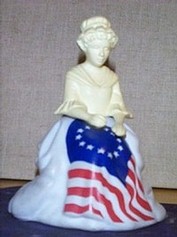 |
From the first flag by Betsy Ross to the Old Glory of World War II, U.S. flags were made of hemp. |
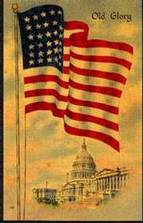 |
10. HEMP FOR VICTORY
Text of the World War II film by the U.S. Department of Agriculture, made to encourage farmers to plant hemp for the war effort. This important film shows that hemp can be brought back for use when an emergency demands it. Saving the earth from global warming sounds like a good enough emergency.
11. SAILING SHIPS
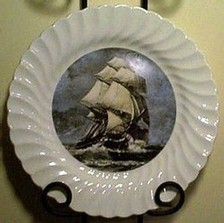 |
Hemp rules the seas. Hemp rope and sails
carried the passenger, commerce and warships for thousands of
years, until the invention of steam engines in the early 1800's.
Hemp Museum plate showing the U.S.S. Constitution, our national sailing ship, now in Boston Harbor. |
17. CLIPPER SHIPS
If you would like to join the USA Hemp Museum
Richard M. Davis:
Help support the USA
Hemp Museum
Please Make A
Donation
and/or buy the books
or communicate with the curator, send an
email to
Curator, Founder, Author
To The USA Hemp Museum's Building Fund
So We Can Make Public Our Collection
Of
Over 1,700 Hemp History Items
|
Richard M. Davis |
|
|
USA Hemp Museum Store - Bookmark This Site - Museum Link - Email The Museum
